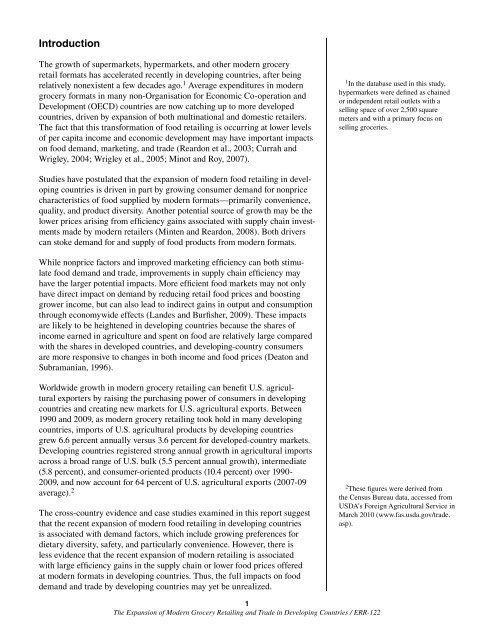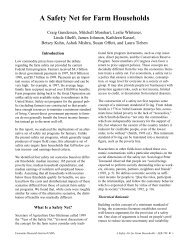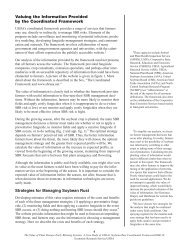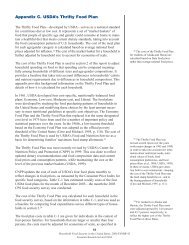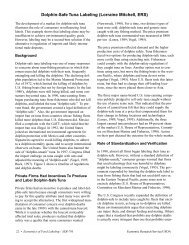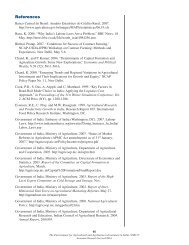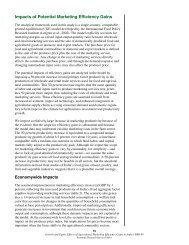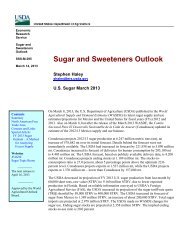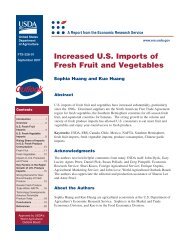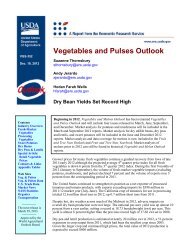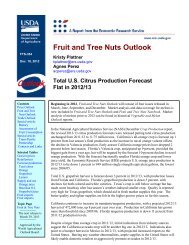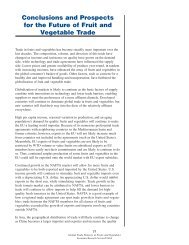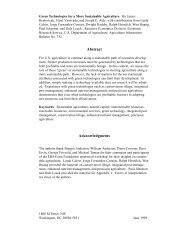Expansion of Modern Grocery Retailing and Trade in - Economic ...
Expansion of Modern Grocery Retailing and Trade in - Economic ...
Expansion of Modern Grocery Retailing and Trade in - Economic ...
Create successful ePaper yourself
Turn your PDF publications into a flip-book with our unique Google optimized e-Paper software.
Introduction<br />
The growth <strong>of</strong> supermarkets, hypermarkets, <strong>and</strong> other modern grocery<br />
retail formats has accelerated recently <strong>in</strong> develop<strong>in</strong>g countries, after be<strong>in</strong>g<br />
relatively nonexistent a few decades ago. 1 Average expenditures <strong>in</strong> modern<br />
grocery formats <strong>in</strong> many non-Organisation for <strong>Economic</strong> Co-operation <strong>and</strong><br />
Development (OECD) countries are now catch<strong>in</strong>g up to more developed<br />
countries, driven by expansion <strong>of</strong> both mult<strong>in</strong>ational <strong>and</strong> domestic retailers.<br />
The fact that this transformation <strong>of</strong> food retail<strong>in</strong>g is occurr<strong>in</strong>g at lower levels<br />
<strong>of</strong> per capita <strong>in</strong>come <strong>and</strong> economic development may have important impacts<br />
on food dem<strong>and</strong>, market<strong>in</strong>g, <strong>and</strong> trade (Reardon et al., 2003; Currah <strong>and</strong><br />
Wrigley, 2004; Wrigley et al., 2005; M<strong>in</strong>ot <strong>and</strong> Roy, 2007).<br />
Studies have postulated that the expansion <strong>of</strong> modern food retail<strong>in</strong>g <strong>in</strong> develop<strong>in</strong>g<br />
countries is driven <strong>in</strong> part by grow<strong>in</strong>g consumer dem<strong>and</strong> for nonprice<br />
characteristics <strong>of</strong> food supplied by modern formats—primarily convenience,<br />
quality, <strong>and</strong> product diversity. Another potential source <strong>of</strong> growth may be the<br />
lower prices aris<strong>in</strong>g from efficiency ga<strong>in</strong>s associated with supply cha<strong>in</strong> <strong>in</strong>vestments<br />
made by modern retailers (M<strong>in</strong>ten <strong>and</strong> Reardon, 2008). Both drivers<br />
can stoke dem<strong>and</strong> for <strong>and</strong> supply <strong>of</strong> food products from modern formats.<br />
While nonprice factors <strong>and</strong> improved market<strong>in</strong>g efficiency can both stimulate<br />
food dem<strong>and</strong> <strong>and</strong> trade, improvements <strong>in</strong> supply cha<strong>in</strong> efficiency may<br />
have the larger potential impacts. More efficient food markets may not only<br />
have direct impact on dem<strong>and</strong> by reduc<strong>in</strong>g retail food prices <strong>and</strong> boost<strong>in</strong>g<br />
grower <strong>in</strong>come, but can also lead to <strong>in</strong>direct ga<strong>in</strong>s <strong>in</strong> output <strong>and</strong> consumption<br />
through economywide effects (L<strong>and</strong>es <strong>and</strong> Burfisher, 2009). These impacts<br />
are likely to be heightened <strong>in</strong> develop<strong>in</strong>g countries because the shares <strong>of</strong><br />
<strong>in</strong>come earned <strong>in</strong> agriculture <strong>and</strong> spent on food are relatively large compared<br />
with the shares <strong>in</strong> developed countries, <strong>and</strong> develop<strong>in</strong>g-country consumers<br />
are more responsive to changes <strong>in</strong> both <strong>in</strong>come <strong>and</strong> food prices (Deaton <strong>and</strong><br />
Subramanian, 1996).<br />
Worldwide growth <strong>in</strong> modern grocery retail<strong>in</strong>g can benefit U.S. agricultural<br />
exporters by rais<strong>in</strong>g the purchas<strong>in</strong>g power <strong>of</strong> consumers <strong>in</strong> develop<strong>in</strong>g<br />
countries <strong>and</strong> creat<strong>in</strong>g new markets for U.S. agricultural exports. Between<br />
1990 <strong>and</strong> 2009, as modern grocery retail<strong>in</strong>g took hold <strong>in</strong> many develop<strong>in</strong>g<br />
countries, imports <strong>of</strong> U.S. agricultural products by develop<strong>in</strong>g countries<br />
grew 6.6 percent annually versus 3.6 percent for developed-country markets.<br />
Develop<strong>in</strong>g countries registered strong annual growth <strong>in</strong> agricultural imports<br />
across a broad range <strong>of</strong> U.S. bulk (5.5 percent annual growth), <strong>in</strong>termediate<br />
(5.8 percent), <strong>and</strong> consumer-oriented products (10.4 percent) over 1990-<br />
2009, <strong>and</strong> now account for 64 percent <strong>of</strong> U.S. agricultural exports (2007-09<br />
average). 2<br />
The cross-country evidence <strong>and</strong> case studies exam<strong>in</strong>ed <strong>in</strong> this report suggest<br />
that the recent expansion <strong>of</strong> modern food retail<strong>in</strong>g <strong>in</strong> develop<strong>in</strong>g countries<br />
is associated with dem<strong>and</strong> factors, which <strong>in</strong>clude grow<strong>in</strong>g preferences for<br />
dietary diversity, safety, <strong>and</strong> particularly convenience. However, there is<br />
less evidence that the recent expansion <strong>of</strong> modern retail<strong>in</strong>g is associated<br />
with large efficiency ga<strong>in</strong>s <strong>in</strong> the supply cha<strong>in</strong> or lower food prices <strong>of</strong>fered<br />
at modern formats <strong>in</strong> develop<strong>in</strong>g countries. Thus, the full impacts on food<br />
dem<strong>and</strong> <strong>and</strong> trade by develop<strong>in</strong>g countries may yet be unrealized.<br />
1<br />
The <strong>Expansion</strong> <strong>of</strong> <strong>Modern</strong> <strong>Grocery</strong> <strong>Retail<strong>in</strong>g</strong> <strong>and</strong> <strong>Trade</strong> <strong>in</strong> Develop<strong>in</strong>g Countries / ERR-122<br />
1 In the database used <strong>in</strong> this study,<br />
hypermarkets were def<strong>in</strong>ed as cha<strong>in</strong>ed<br />
or <strong>in</strong>dependent retail outlets with a<br />
sell<strong>in</strong>g space <strong>of</strong> over 2,500 square<br />
meters <strong>and</strong> with a primary focus on<br />
sell<strong>in</strong>g groceries.<br />
2 These figures were derived from<br />
the Census Bureau data, accessed from<br />
USDA’s Foreign Agricultural Service <strong>in</strong><br />
March 2010 (www.fas.usda.gov/trade.<br />
asp).


